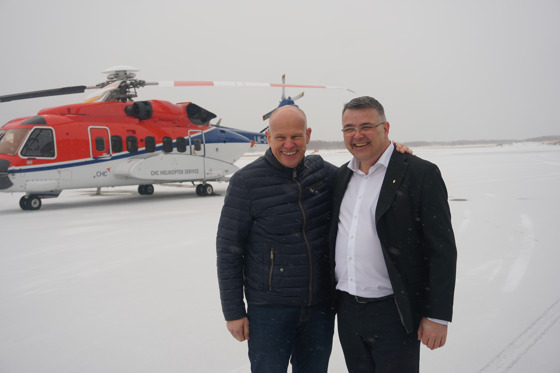Arctic Gas to European Customers
Historical archive
Published under: Solberg's Government
Publisher: Ministry of Petroleum and Energy
Speech/statement | Date: 11/03/2019
On March 8th, the international woman's day, we celebrated the opening of a new platform named after a leading figure in the Norwegian women’s rights movement in the late 1800s, Aasta Hansteen.

Left: Arne Sigve Nylund (Equinor) and Minister Kjell-Børge Freiberg in Brønnøysund, Norway.
Production start on the Aasta Hansteen field in the Norwegian Sea marks a new chapter in Norwegian gas history. For the first time, we now deliver natural gas from beyond the Arctic Circle through our pipeline system to Europe, via the new Polarled pipeline.
Stable access to reliable and affordable energy is key to both social and economic development. It is an important policy goal in Europe as well as in the rest of the world. Furthermore, energy policy goals must align with policies concerning both local emission issues as well as the global climate challenge. The world needs to change its long-term path in order to have a less emission-intensive energy system. Gas has an important role to play in this regard.
Covering about 25 percent of the gas consumption in Europe, Norwegian natural gas plays a central role in EU energy supply. More than 95 percent of Norway's natural gas is exported through the world's largest upstream pipeline network offshore to the major gas hubs in the UK and on the Continent.
Most of Norway's remaining resources of oil and gas are located in the high north. Due to the Gulf Stream, all areas in Norwegian waters opened for petroleum activity are ice-free in a normal year. Operating conditions for oil and gas production are therefore quite similar to conditions further south. Developing oil and gas resources in the north are key to maintaining high production from our continental shelf. This is important also in a European perspective.
An enabler in the energy transition
I believe natural gas has a key role to play in the European energy mix for decades to come. Europe is in the midst of an energy transition aimed at delivering emission cuts. A quick and cheap way to reduce emissions is to replace coal with gas. We see this demonstrated for instance in the UK, but also in the United States and China. In The UK, the combination of natural gas and wind power was the main factor bringing carbon emissions in 2018 to the lowest level since 1888, the same year Tower Bridge was built. Emissions in the UK are now almost 40 per cent below 1990 levels.
Declining costs and the growth of renewable energy in Europe is both inspiring and most welcome. However, the growth of intermittent energy sources like wind and solar increases the need for a flexible partner to handle variations in demand and supply. Natural gas is affordable, accessible and storable. Given the flexibility of natural gas, it can respond quickly on days when the sun does not shine or the wind does not blow. In the long term, conversion of natural gas to hydrogen combined with carbon capture and storage (CCS) could be an option to develop a zero-emission energy sector.
Efficient energy markets
Since the turn of the century, Europe has come a long way in developing an increasingly efficient and flexible energy market with diversified supply, supported by sufficient infrastructure. The next few years will see new supply pipelines built, and more liquefied natural gas (LNG) available in the global market. European gas customers will have an even wider choice of potential suppliers and delivery routes, and thus a wider range of opportunities in terms of supply sources.
Energy is first and foremost a market-based commodity. If the market works, oil, gas and electricity will flow from producers to consumers in an efficient manner. In my view, the main role for the authorities to make this happen is to design a technology neutral framework that triggers the necessary incentives, to both generate and transport more energy and reduce emissions. It is vital that long-term policies do not undermine the market mechanism. Putting a price on CO2 emissions is the most efficient way to stimulate the players in the market to seek the most efficient solutions to cut emissions.
From the Norwegian Government’s perspective, we are committed to maintaining a stable framework that contributes to both profitable and sustainable production on the Norwegian Continental Shelf. Environmental considerations, including the regulation of greenhouse gas emissions, are integral to our petroleum policy, and have been so for a long time. The carbon footprint of Norwegian oil and gas is significantly lower than most other petroleum exporters.
Record high gas exports
Norwegian petroleum production has gradually shifted towards natural gas. The last few years we have delivered record amounts of gas to European customers. We have the resources needed to remain a major, reliable and long-term supplier of gas to Europe. This mutual dependence between Norway and the European countries is to the benefit of both parties, and is central to reaching our common goal of energy security and a reduction of greenhouse gas emissions.